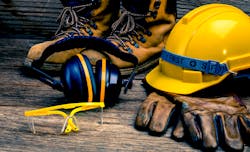Frank was back in the office after leave following his wife’s surgery, and every time he rose from his desk, he made an exaggerated step over some invisible object.
“What’s going on, Frank?” He paused, after muttering to himself, at first oblivious to his peculiar motion. “Oh, it’s the kids’ toys or it’s the laundry… I kept tripping over stuff.” So, he adjusted by stepping over obstacles instead of removing them.
We do the same thing when it comes to safety. We become so familiar with obstacles at our workplace, in our truck and around our local roads that we figuratively “step over” them instead of eliminating safety hazards. The problem is our “stepping” diverts our attention, for however short a moment, from the task at hand. And the obstacles still exist for others to trip over. Let’s look at some common obstacles and what can be done to remove them.
Workplace obstacles
Every truck terminal or distribution center has a truck parking area and a distance drivers and others must walk to the office, the driver’s lounge or the restrooms. Many locations have painted walkways to direct that pedestrian traffic and alert moving vehicles to potential danger. The problem is that people naturally take the most efficient route, not necessarily the designated walkway. Local employees and workers may know the patterns, but visitors don’t. Consider removing that safety obstacle by reconfiguring the painted walkways to reflect actual use.
Terminals with maintenance facilities oftentimes have large bins outside of the truck bays for easy disposal of discarded parts and associated waste. Those bins can block the ready view of trucks backing out of the bays. Again, locals know to “step over” this obstacle by slowing down or taking another route through the yard. But if the bin itself cannot be repositioned, a warning sign or flashing light can remove it as an obstacle for others.
In-cab obstacles
Bad habits are also safety obstacles. Whether in a truck or a personal vehicle, too often we start driving before we are fully settled in for the journey. We see it on the road every day – some driver glancing down at a map or smartphone, trying to figure out his next turn. A confused driver is an unsafe driver. But so are we if our on-road attention is diverted by steps we should take before starting the engine: adjust seat, adjust mirrors, buckle seatbelt, secure coffee cup/thermos and any smart device if needed, review route. Don’t “step over” these steps.
Local road obstacles
The National Highway Traffic Safety Administration says that most car accidents occur within five miles of home and 69% happen within 10 miles. For trucks, the distance is only a bit more. Sure, the statistic is somewhat skewed; all trips begin or end locally, and many trips are short in length. One cause of local accidents, though, are the local roads themselves - many times road conditions and hazards we have learned to avoid (“step over”) but have not corrected. It’s not our job to fix the roads? No, but it is our responsibility to alert those who can.
In California the Highway Patrol (CHP) and the truckers did exactly that. The CHP photographed confusing road signs (my favorite was a sign at a T-intersection, reading “End Truck Route.” The question asked by our officer was, “Now what?”). Meanwhile, local truck drivers, equipped with disposable cameras, documented the truck cab view of dangerous conditions – busy street corners obscured by overgrown brush, a “Yield to Oncoming Traffic” sign positioned where only passenger cars could see. Our city and county officials were only too happy to fix these problems, once documented.
Back at the office, Frank is now walking normally, without the exaggerated step. We can also improve our workplace by being aware of safety obstacles and removing them once and for all. Safety does indeed begin at home.
About the Author
Steve Vaughn
Senior Vice President of Field Operations
Steve Vaughn is senior vice president of field operations at PrePass Safety Alliance, the provider of PrePass weigh station bypass and electronic toll-payment and management services. Vaughn served nearly three decades with the California Highway Patrol and is a past president of the Commercial Vehicle Safety Alliance.
